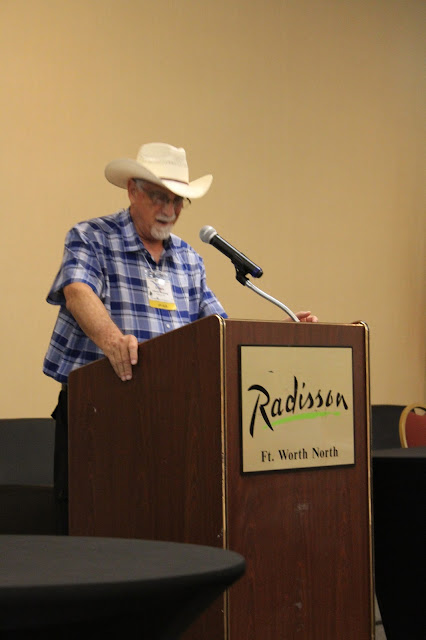My daughter, Dr. Berri O'Neal Gormley, and her family - husband Drew and my three youngest grandchildren, Addie, Reagan, and Nolan - moved to Colleyville in 2015. Berri minored in history, an interest she has maintained throughout her life, and for the past year she has provided the technological expertise necessary to produce this blog. On previous visits to Colleyville, I asked Berri to show me historical sites and venerable buildings. This summer she went exploring, and when I visited in early July she offered to give me an historical tour of her community.
Berri and I next visited the Bidault House, which was designed and built by Anthelm Bidault, a farmer and winemaker. The house was constructed of molded concrete blocks during the years 1905-1911. Bidault was noted for cultivating orchards, vineyards, and berry fields on his farm. During World War I French soldiers stationed at Camp Bowie in Fort Worth were entertained at the Bidault home. Two years after the war the Bidault family moved back to France, but their well-built residence is a tangible reminder of their stay in Texas.

 |
| Old Bedford School |
 |
| The 1908 Bedford School is on the National Register of Historic Buildings. |
Berri explained to me that into the 1950s Colleyville was an unincorporated village. Today's Colleyville town site long was made up of farms and small rural communities. One of these communities was Bedford, and Berri first took me to the 1908 Bedford School. In the years before the Civil War, the first Bedford area school house was a log building. Soon after the war ended, a frame school was erected. When that school burned in the early 1880s, a citizen named Milton Moore donated land for a school campus. When that building also burned in 1893, an elementary school was erected nearby. In 1908 this structure was replaced by a two-story brick school. When Bedford consolidated with the Hurst-Euless district in 1958, the brick school continued to be used, with a large addition to the rear, until 1969. The old Bedford School has since been handsomely restored and stands impressively on the traditional school site.
 |
| Main stairway to second-floor classrooms |
 |
| Bidault House |

 |
| Cistern base |
Our next stop was at the Webb House, built in 1914 by John R. Webb, a citizen of Bransford. His earlier home in Bransford had burned, but Webb erected a one-and-one-half story house on a T-floor plan, with a spacious front porch and side porches. Webb arrived at rural Bransford from Tennessee in 1897. Webb worked for the Cotton Belt Railroad for 44 years, and he also owned Bransford's last general store. Prominent in community affairs, he was active in the Woodmen of the World lodge, a trustee of the Pleasant Run School, the unofficial mayor of Bransford, and manager of the Grapevine Rabbit Twisters, a popular fiddle band. The Webb House was restored through community efforts in 2002, and fittingly a venerable caboose was placed nearby.
 |
| The "Preservation" area is marked. |
 |
| Webb House |
 |
| Storm cellar |
 |
| Caboose reminds visitors that Webb worked 44 years as a railroad man |
Rural communities such as Bransford, Pleasant Run, Bedford, and others began to be settled in the 1850s. Dr. Howard Colley moved to Texas in 1880, settled in Bransford, and practiced medicine for the next 40 years. A community grew up near his home and around a store founded in 1914 which took on the name of the beloved country doctor, Coleysville and, later, Colleyville. There were two businesses and 25 people in Colleyville in 1936. Two decades later Colleyville was incorporated, and in 1958 a population of 100 was reported. Growth was slow but steady, and today the population exceeds 26,000. And there is enough interest in local history to preserve remnants of early village life in the vicinity.
 |
| Daughter Berri, a resident of Colleyville, at the Old Bedford School |











































